*NURSING > EXAM > NUR 155 Med Surg Test 3, Exam Questions & Answers, Deeply Explained With Rationales (All)
NUR 155 Med Surg Test 3, Exam Questions & Answers, Deeply Explained With Rationales
Document Content and Description Below
NUR 155 Med Surg Test 3, Exam Questions & Answers, Deeply Explained With Rationales-A severely obese patient has undergone Roux-en-Y gastric bypass surgery. In planning postoperative care, the nurse a... nticipates that the patient A. may have severe diarrhea early in the postoperative period. B. will not be allowed to ambulate for 1 to 2 days postoperatively. C. will require nasogastric suction until the incision heals. D. may have only liquids orally, and in very limited amounts, during the postoperative period. - D. may have only liquids orally, and in very limited amounts, during the postoperative period. Rationale: During the immediate postoperative period, water and sugar-free clear liquids are given (30 mL every 2 hours while the patient is awake). You are providing care to a patient with COPD who is receiving medical treatment for exacerbation. The patient has a history of diabetes, hypertension, and hyperlipidemia. The patient is experiencing extreme hyperglycemia. In addition, the patient has multiple areas of bruising on the arms and legs. Which medication ordered for this patient can cause hyperglycemia and bruising? A) Prednisone B) Atrovent C) Flagyl D) Levaquin - A) Prednisone Rationale: Prednisone is a corticosteroid and can cause hyperglycemia and bruising. (SATA) Which of the following statements are incorrect about discharge teaching that you would provide to a patient with COPD? 1. "It is best to eat three large meals a day that are relatively low in calories 2. "Avoid going outside during extremely hot or cold days." 3. "It is important to receive the Pneumovax vaccine annually." 4. "Smoking cessation can help improve your symptoms." A) 1,4 B) 1,3 C) 2,4 D) 1,2,3 E) All of these F) None - B) 1,3 Rational: The answers are 1 and 3. The patient needs to eat high calorie and protein rich meals that are small but frequent. The pneumovax is definitely recommended for patients with COPD but is given every 5 years (not annually). Clients with chronic illnesses are more likely to get pneumonia when which of the following situations is present? A. Dehydration B. Group living C. Malnutrition D. Severe periodontal disease - B. Group living Rationale: Clients with chronic illnesses generally have poor immune systems. Often, residing in group living situations increases the chance of disease transmission. Pneumonia is a fairly prevalent disease and carries a heavy burden in all populations. A study carried out by the US Centers for Disease Control and Prevention (CDC) aimed at estimating its burden in North America found that CAP accounted for the eighth leading cause of mortality in the United States and the seventh leading cause of mortality in Canada after adjusting for various gender and age differences. - Option A: Pneumonia can also cause dehydration from fever and decreased thirst and appetite, which may require treatment with extra fluids intravenously. Potential benefits of fluids are replacing fluid lost because of fever or rapid breathing, treating dehydration, and reducing the viscosity of mucus. - Option C: Pneumonia is common in malnourished children and is frequently associated with fatal outcomes, especially in children younger than 24 months of age. Studies consistently reported a two- to threefold greater risk of mortality in cases with pneumonia associated with malnutrition. Therefore, pneumonia and malnutrition are two of the biggest killers in childhood diseases. - Option D: Various pathogenic bacteria have been found in patients with deep periodontal pockets. The association between periodontal disease and pneumonia may be due to colonization by pathogenic bacteria in the periodontal pocket, as inhalation of a pathogen is considered a risk factor for pneumonia Which of the following organisms most commonly causes community-acquired pneumonia in adults? A. Haemophilus influenzae B. Klebsiella pneumoniae C. Streptococcus pneumoniae D. Staphylococcus aureus - C. Streptococcus pneumoniae Rationale: Pneumococcal or streptococcal pneumonia, caused by streptococcus pneumoniae, is the most common cause of community-acquired pneumonia. Streptococcus pneumoniae is the bacterium that has historically been the most common pathogen to cause CAP worldwide. In the era before antibiotics, S. pneumoniae was estimated to be the cause of 95% of all cases of pneumonia. Currently, however, S. pneumoniae accounts for up to 15% of pneumonia cases in the United States and 27% of cases worldwide today. -Option A: H. influenzae is the most common cause of infection in children. Haemophilus influenzae is a bacteria characterized as a small, facultatively anaerobic, pleomorphic, and capnophilic gram-negative coccobacillus of the family Pasteurellaceae. It is a common cause of a variety of invasive and non-invasive bacterial infections. -Option B: Klebsiella species is the most common gram-negative organism found in the hospital setting. Today, K. pneumoniae pneumonia is considered the most common cause of hospital-acquired pneumonia in the United States, and the organism accounts for 3% to 8% of all nosocomial bacterial infections. -Option D: Staphylococcus aureus is the most common cause of hospital-acquired pneumonia. Staphylococcus aureus is a major bacterial human pathogen that causes a wide variety of clinical manifestations. Infections are common both in community-acquired as well as hospital-acquired settings and treatment remains challenging to manage due to the emergence of multi-drug resistant strains such as MRSA (Methicillin-Resistant Staphylococcus aureus). An elderly client with pneumonia may appear with which of the following symptoms first? A. Altered mental status and dehydration B. Fever and chills C. Hemoptysis and dyspnea D. Pleuritic chest pain and cough - A. Altered mental status and dehydration Rational: Fever, chills, hemoptysis, dyspnea, cough, and pleuritic chest pain are common symptoms of pneumonia, but elderly clients may first appear with only an altered mental status and dehydration due to a blunted immune response. A small fraction of patients may have an altered mental status, abdominal pain, chest pain, and other systemic findings. - Option B: Historically, the chief complaints in case of pneumonia include systemic signs like fever with chills, malaise, loss of appetite, and myalgia. These findings are more common in viral pneumonia as compared to bacterial pneumonia. - Option C: Pulmonary findings include cough with or without sputum production. Bacterial pneumonia is associated with purulent or rarely blood-tinged sputum. Viral pneumonia is associated with watery or occasionally mucopurulent sputum production. - Option D: There may be an associated pleuritic chest pain with the concomitant involvement of the pleura. Dyspnea and a diffuse heaviness of the chest are also seen occasionally. The cough may be either non productive or productive with mucoid, purulent, or blood-tinged sputum. A diagnosis of pneumonia is typically achieved by which of the following diagnostic tests? A. ABG analysis B. Chest x-ray C. Blood cultures D. Sputum culture and sensitivity - D. Sputum culture and sensitivity Rational: Sputum C & S is the best way to identify the organism causing the pneumonia. If good quality, sputum evaluation may reveal more than 25 WBC per low-power field and less than 10 squamous epithelial cells. Some bacterial causes present with specific biochemical evidence, such as Legionella, may present with hyponatremia and microhematuria. - Option A: ABG analysis will determine the extent of hypoxia present due to the pneumonia. An arterial blood gas may reveal hypoxia and respiratory acidosis. Pulse oximetry of less than 92% indicates severe hypoxia, and elevated CRP predicts a serious infection. - Option B: Chest x-ray will show the area of lung consolidation. Findings may vary from lobar to interstitial infiltrate, to occasionally cavitary lesions with air-fluid levels suggestive of a more severe disease process. - Option C: Blood cultures will help determine if the infection is systemic. These include a series of tests like blood culture, sputum culture and microscopy, routine blood counts, and lymphocyte count. Special tests such as urinary antigen testing, bronchial aspirate, or induced sputum may be used for certain pathogens. A client with pneumonia develops dyspnea with a respiratory rate of 32 breaths/minute and difficulty expelling his secretions. The nurse auscultates his lung fields and hears bronchial sounds in the left lower lobe. The nurse determines that the client requires which of the following treatments first? A. Antibiotics B. Bed rest C. Oxygen D. Nutritional intake - C. Oxygen Rational: The client is having difficulty breathing and is probably becoming hypoxic. As an emergency measure, the nurse can provide oxygen without waiting for a physician's order. Anticipate the need for supplemental oxygen or intubation if the patient's condition deteriorates. These measures are needed to correct hypoxemia. Intubation is needed for deep suctioning efforts and provides a source for augmenting oxygenation. - Option A: Antibiotics may be warranted, but this isn't a nursing decision. Administer prescribed antimicrobial agents as ordered. To prevent relapse of pneumonia, the patient needs to complete the course of antibiotics as prescribed. - Option B: The client should be maintained on bedrest if he is dyspneic to minimize his oxygen demands, but providing additional will deal more immediately with his problem. Encourage adequate rest balanced with moderate activity. Promote adequate nutritional intake. Facilitates the healing process and enhances natural resistance. - Option D: The client will need nutritional support, but while dyspneic, he may be unable to spare the energy needed to eat and at the same time maintain adequate oxygenation. Maintain adequate nutrition to offset hypermetabolic state secondary to infection. Ask the dietary department to provide a high-calorie, high-protein diet consisting of soft, easy-to-eat foods. A client has been treated with antibiotic therapy for right lower-lobe pneumonia for 10 days and will be discharged today. Which of the following physical findings would lead the nurse to believe it is appropriate to discharge this client? A. Continued dyspnea B. Fever of 102*F C. Respiratory rate of 32 breaths/minute. D. Vesicular breath sounds in the right base. - D. Vesicular breath sounds in right base Rational: If the client still has pneumonia, the breath sounds in the right base will be bronchial, not the normal vesicular breath sounds. If the client still has dyspnea, fever, and increased respiratory rate, he should be examined by the physician before discharge because he may have another source of infection or still have pneumonia. - Option A: Assess the rate, rhythm, and depth of respiration, chest movement, and use of accessory muscles. Tachypnea, shallow respirations, and asymmetric chest movement are frequently present because of the discomfort of moving chest wall and/or fluid in the lung due to a compensatory response to airway obstruction. Altered breathing pattern may occur together with the use of accessory muscles to increase chest excursion to facilitate effective breathing. - Option B: Investigate sudden change in condition, such as increasing chest pain, extra heart sounds, altered sensorium, recurring fever, changes in sputum characteristics. Delayed recovery or increase in severity of symptoms suggests resistance to antibiotics or secondary infection. - Option C: Assess and record respiratory rate and depth at least every 4 hours. The average rate of respiration for adults is 10 to 20 breaths per minute. It is important to take action when there is an alteration in the pattern of breathing to detect early signs of respiratory compromise. The right forearm of a client who had a purified protein derivative (PPD) test for tuberculosis is reddened and raised about 3mm where the test was given. This PPD would be read as having which of the following results? A. Indeterminate B. Needs to be redone C. Negative D. Positive - C. Negative Rational: This test would be classed as negative. A 5 mm raised area would be a positive result if a client was HIV+ or had recent close contact with someone diagnosed with TB. If the patient is at a high risk of developing an active infection, a repeat test is recommended after an initial negative test to rule out the possibility of missing a case. However, a decision is made based on the risk factors. - Option A: Indeterminate isn't a term used to describe results of a PPD test. It is a time-sensitive test. Tests that are read late are not accurate as they tend to underestimate the size of the skin reaction. Therefore, the reliability of the test is compromised, and the results are doubtful. - Option B: To avoid this, repeat testing is recommended if the reaction is not read on time. The second test can be administered as soon as possible. However, if repeated, the test should preferably be performed within 7 days of the initial test to avoid boosting effect. - Option D: If the PPD is reddened and raised 10mm or more, it's considered positive according to the CDC. If the infection risk is very high, the PPD test need not be repeated. The positive PPD test is usually followed by TB symptom assessment, physical exam, and chest radiograph. [Show More]
Last updated: 2 days ago
Preview 5 out of 57 pages

Loading document previews ...
Buy this document to get the full access instantly
Instant Download Access after purchase
Add to cartInstant download
We Accept:

Reviews( 0 )
$13.50
Document information
Connected school, study & course
About the document
Uploaded On
Jun 27, 2024
Number of pages
57
Written in
Additional information
This document has been written for:
Uploaded
Jun 27, 2024
Downloads
0
Views
3






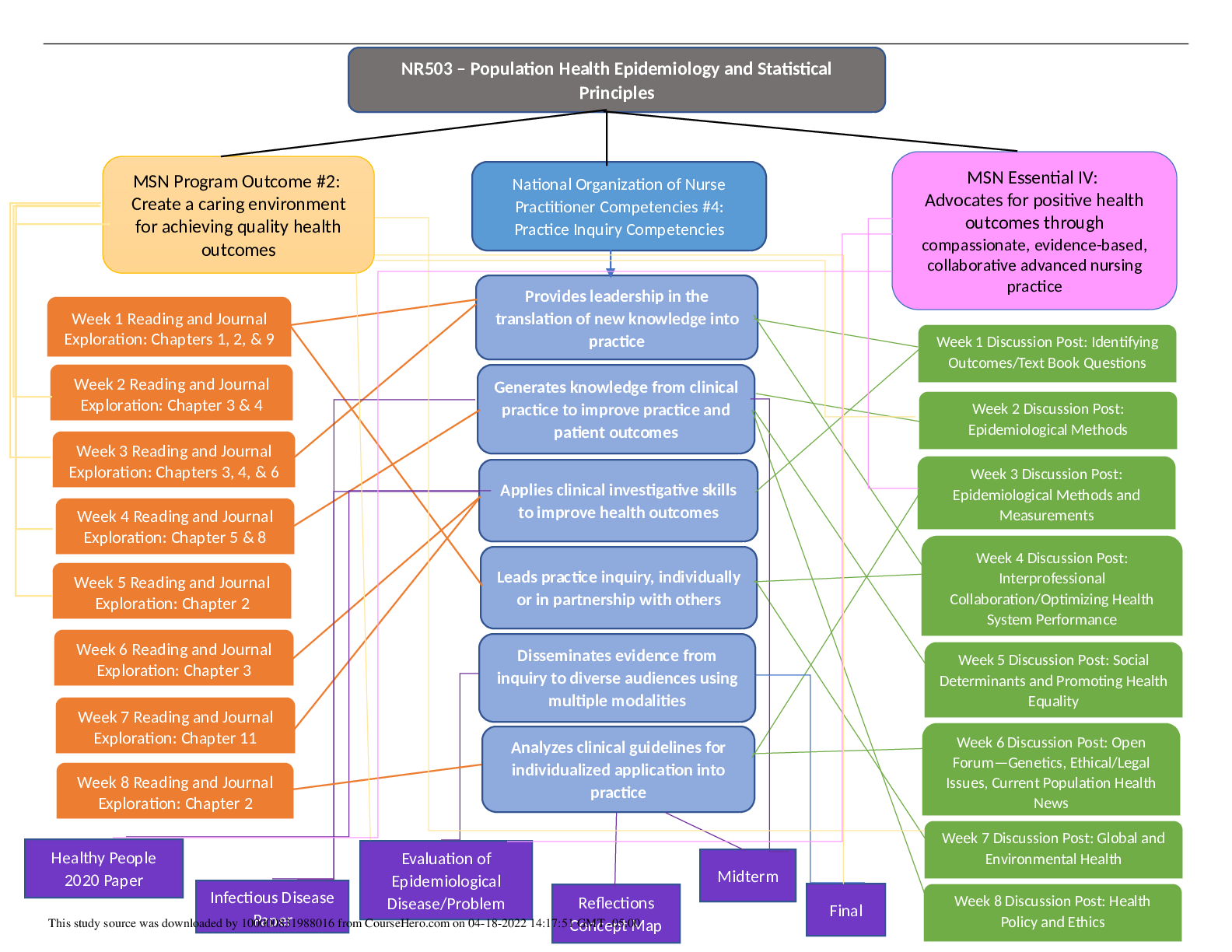

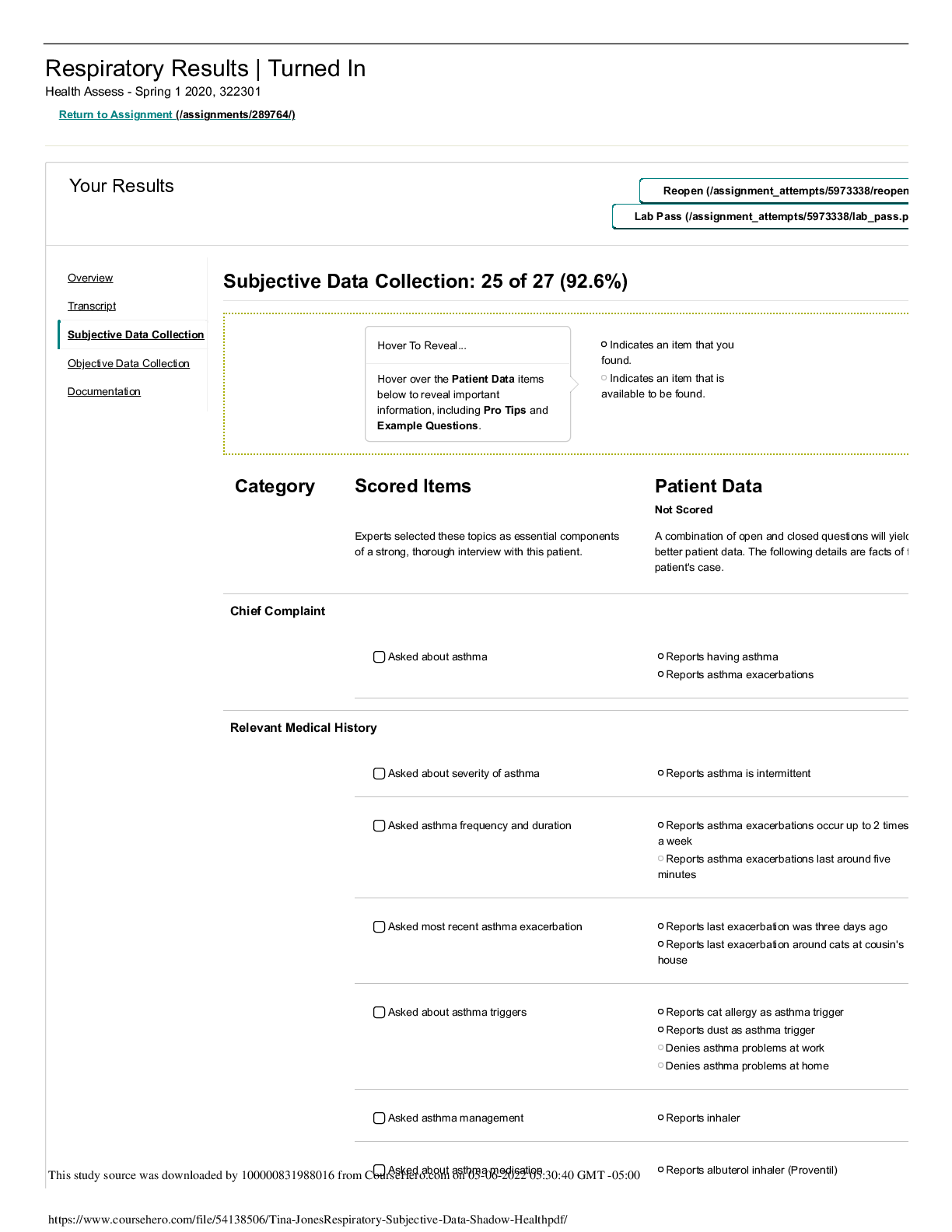
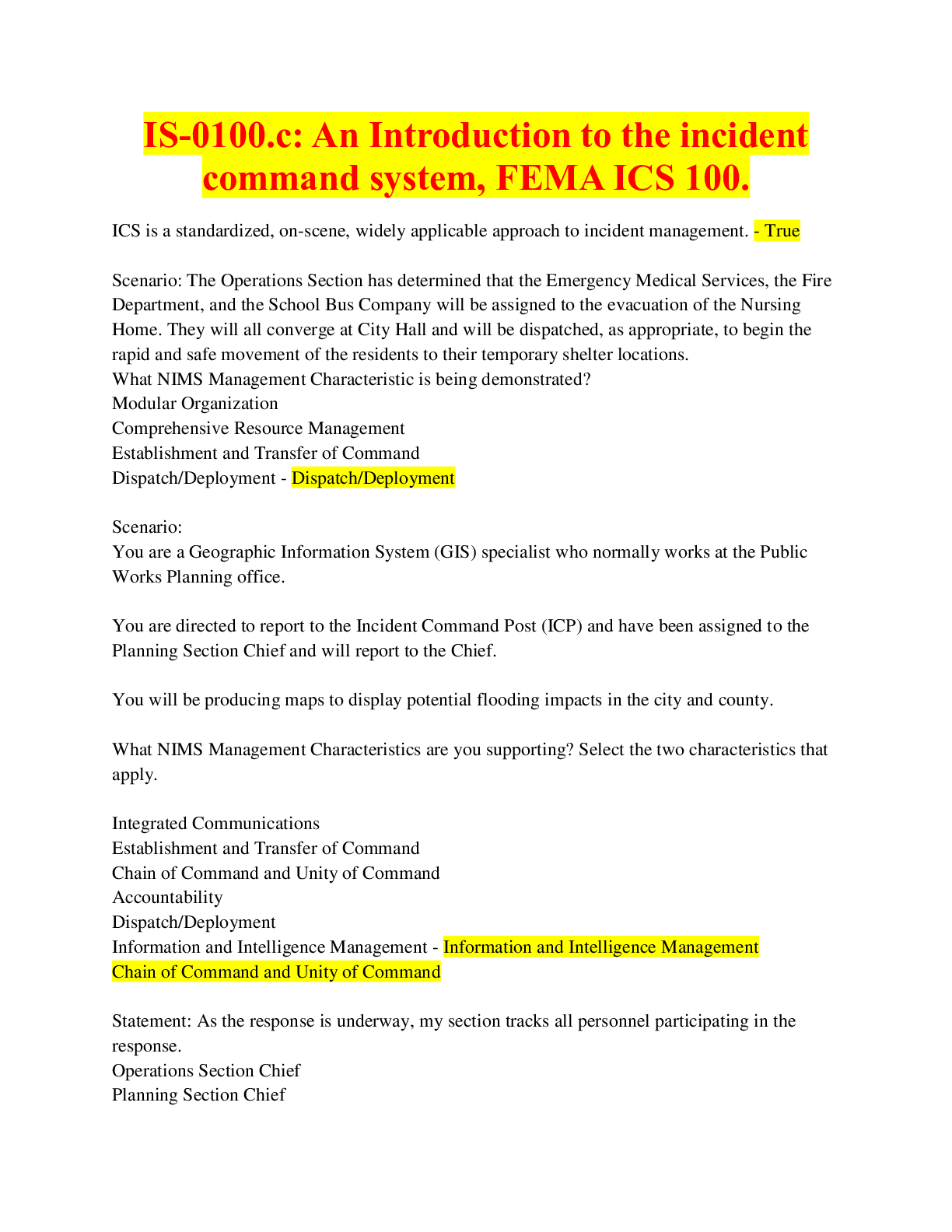



.png)
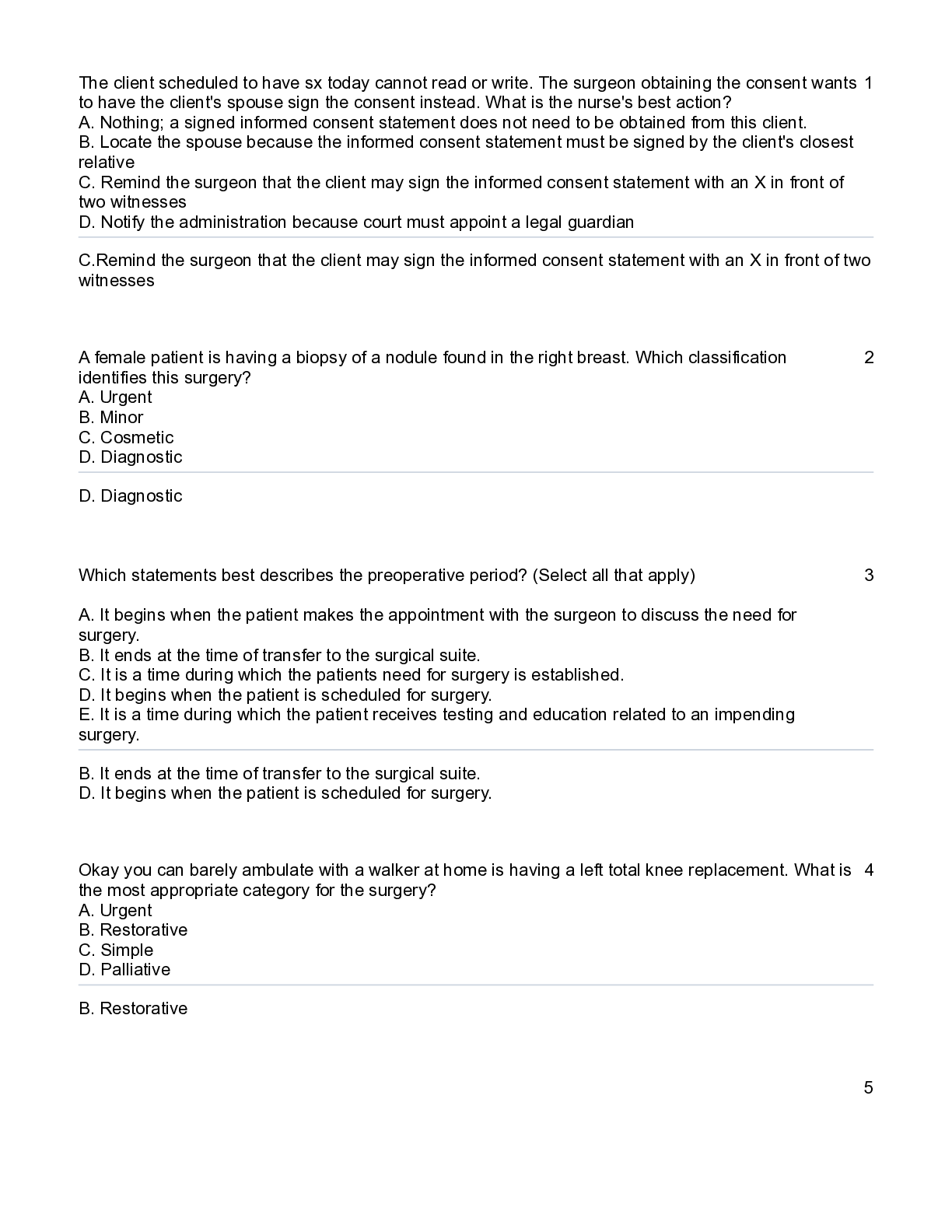

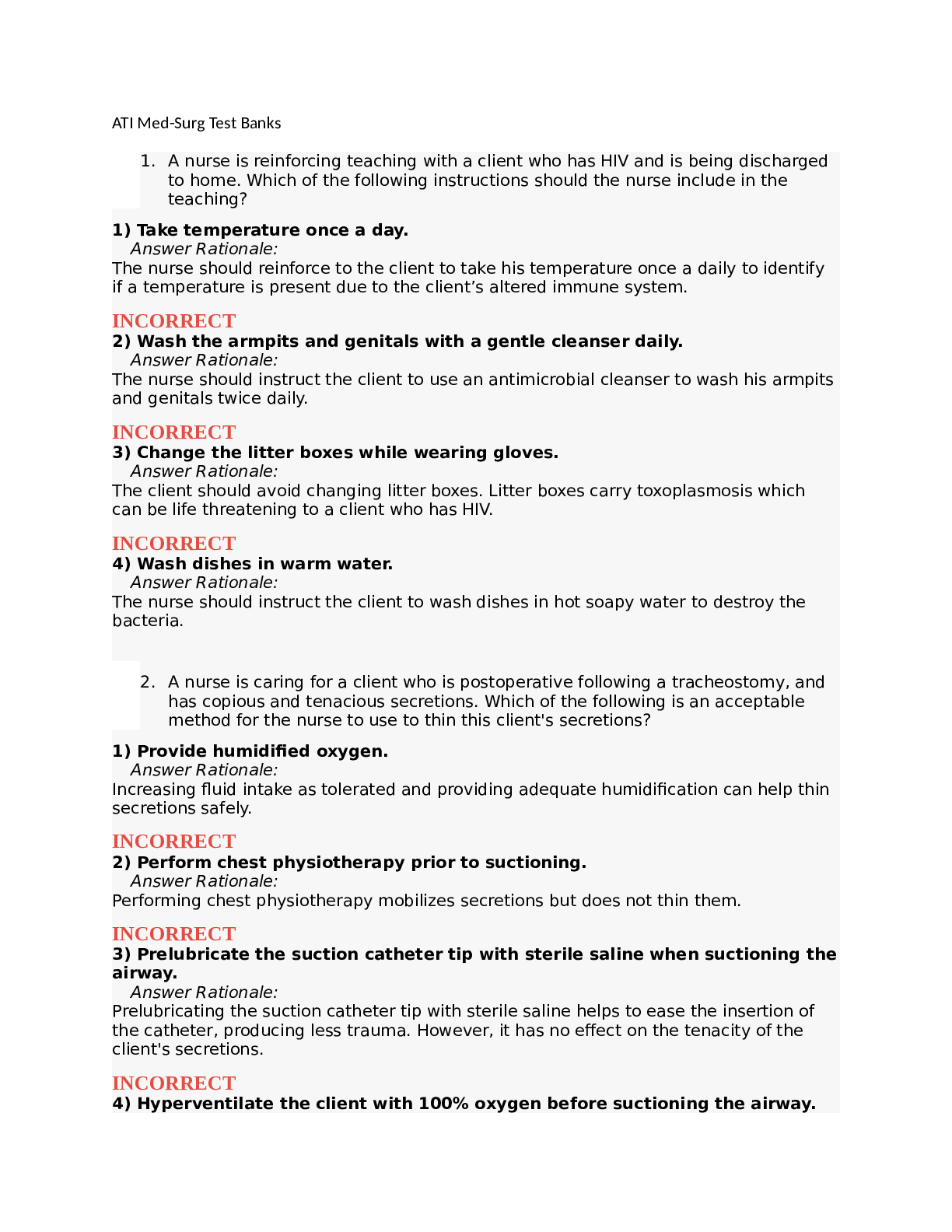
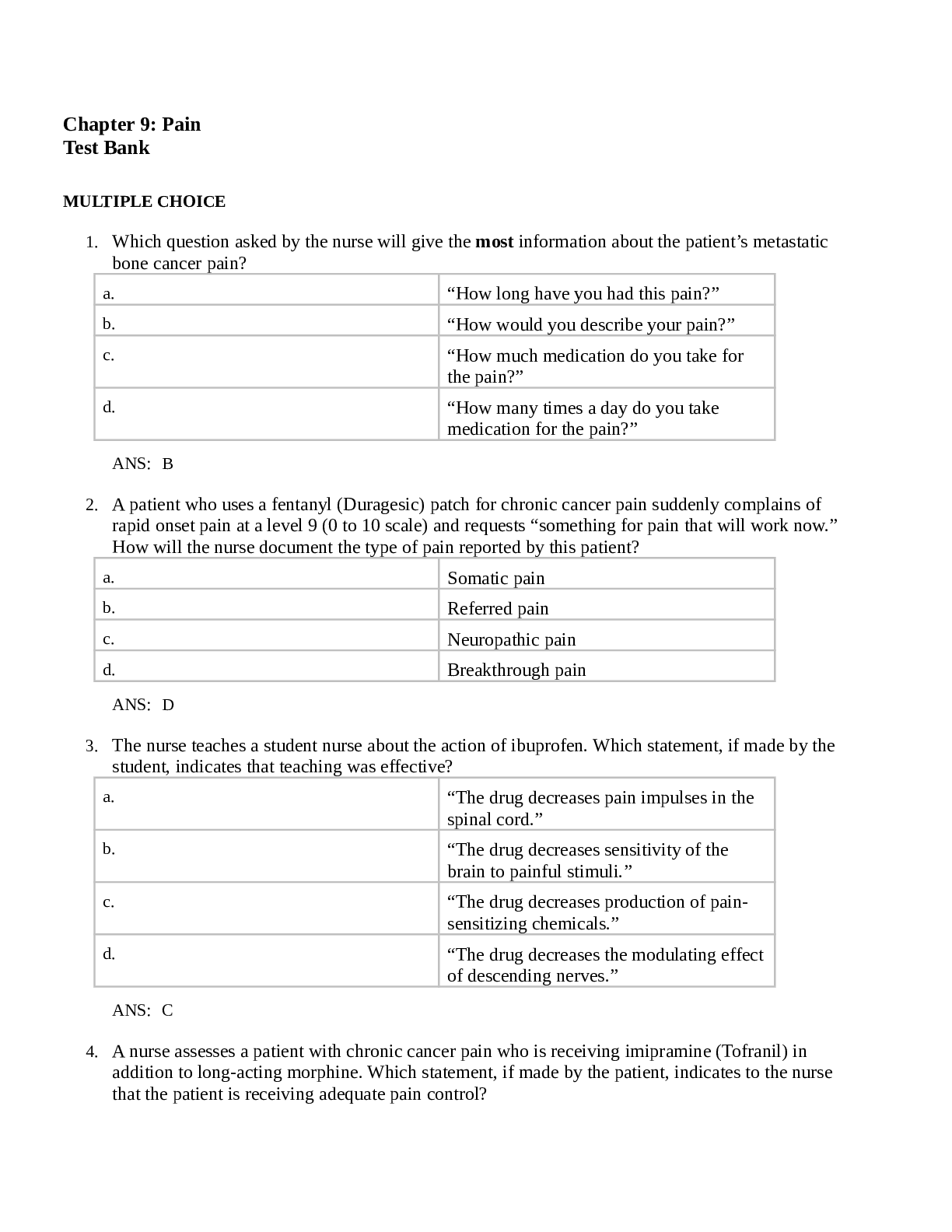
.png)
 (1).png)
 Med Surg test Latest Verified Questions and all Correct Answers with Explanations Chapter 32 Assessment of Hematologic Function and Treatm.png)
 Med Surg test Latest Verified Questions and all Correct Answers with Explanations Chapter 33 Management of Patients with Nonmalignant Hema.png)
 Med Surg test Latest Verified Questions and all Correct Answers with Explanations Chapter 36 Management of Patients with Immune Deficiency.png)
 Med Surg test Latest Verified Questions and all Correct Answers with Explanations Chapter 38 Assessment and Management of Patients with Rh.png)

